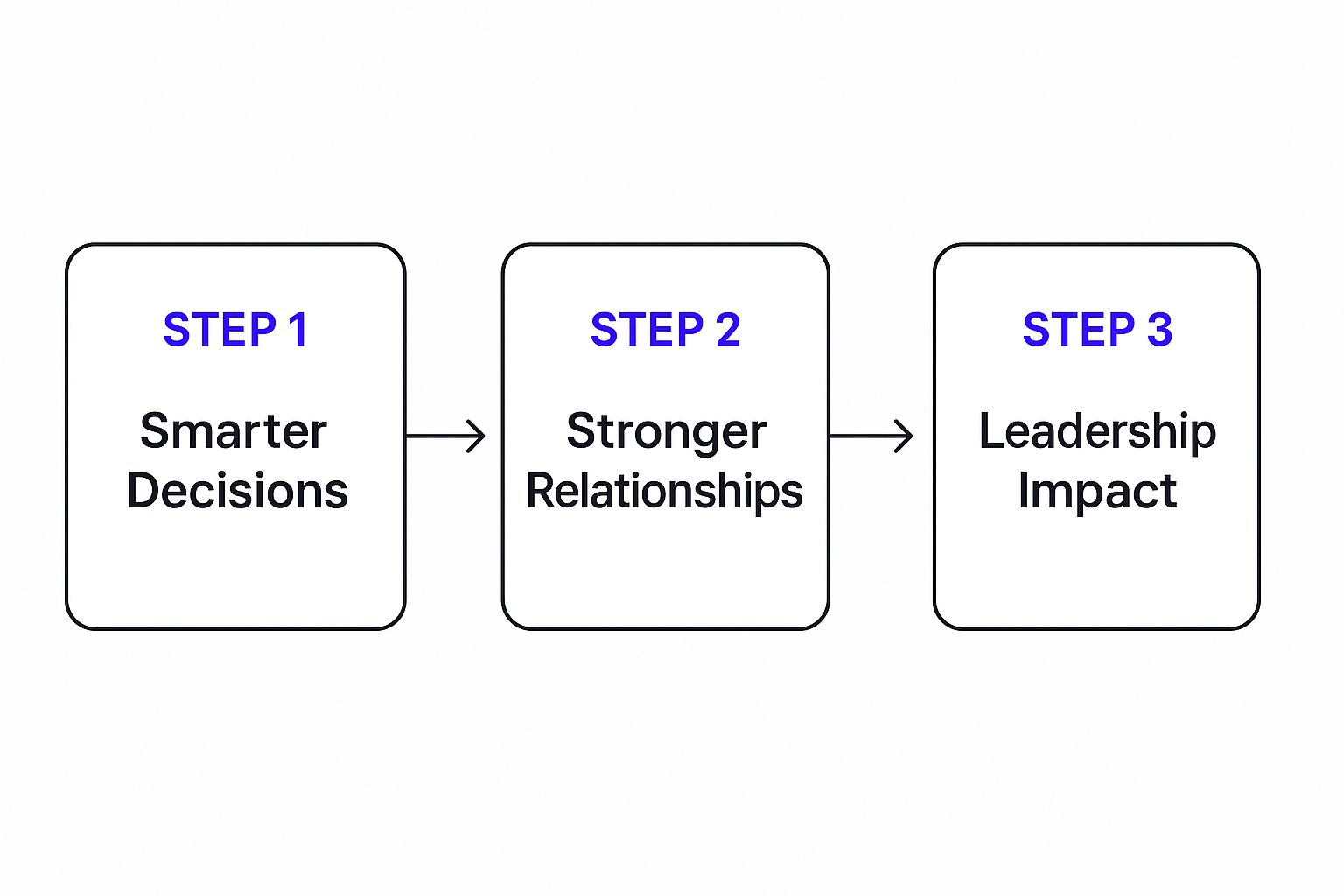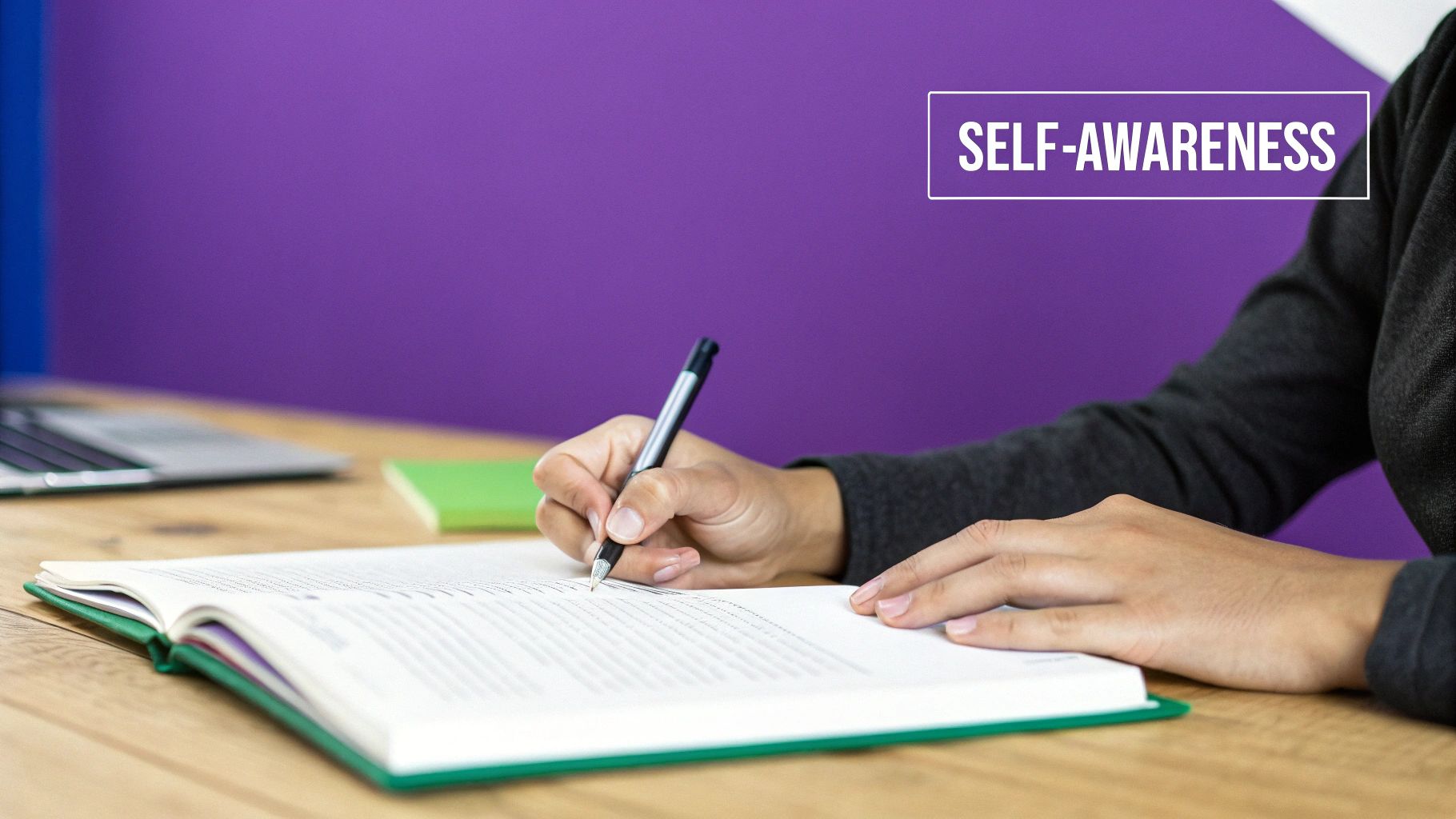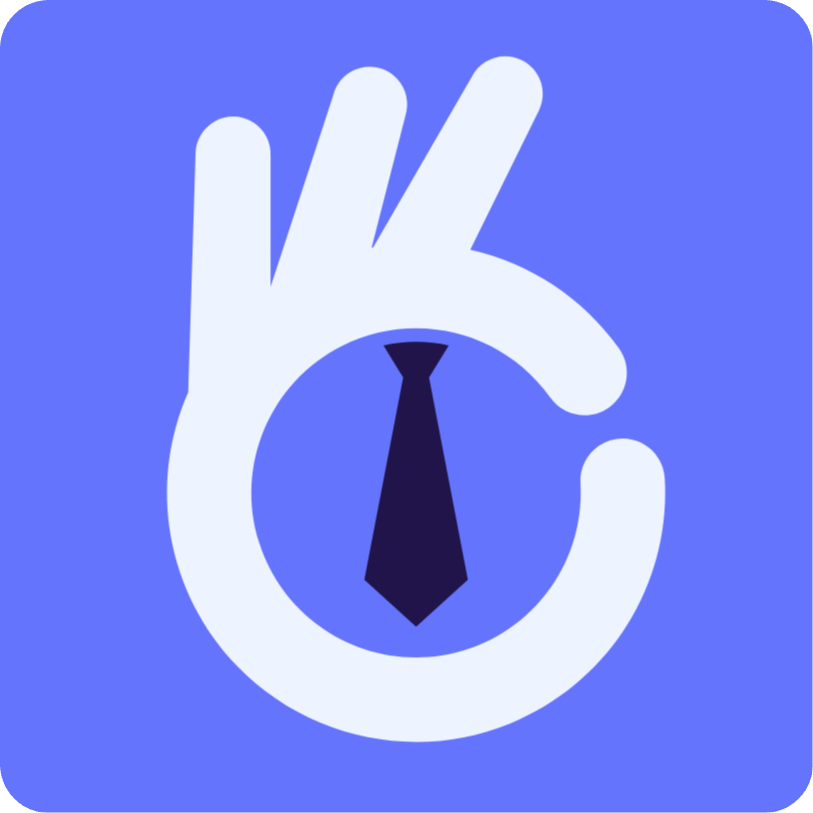How to Build Emotional Intelligence
Building your emotional intelligence isn't some fuzzy, feel-good concept. It's a deliberate process of honing five crucial skills: self-awareness, self-regulation, motivation, empathy, and social skills. This isn't just a "soft skill"—it’s your strategic edge for making sharper decisions, building rock-solid relationships, and leading with real impact.
Why Emotional Intelligence Is Your New Superpower
Let's ditch the idea that emotional intelligence (EI) is just about being "nice." It's actually a potent cognitive ability. It's what allows you to understand, use, and manage your emotions to cut through stress, communicate clearly, and tackle challenges head-on. Think of it as the invisible engine driving smart decisions and inspiring leadership.
People with high EI don't just react; they respond with purpose. That single shift is a game-changer, both at work and in your personal life. When you build emotional intelligence, you're gaining the ability to read the room, resolve conflicts without burning bridges, and genuinely inspire the people around you. It's the difference between a boss who just gives orders and a leader who actually motivates.
The Tangible Benefits of High EI
The perks of a high emotional quotient (EQ) aren't just theoretical. They show up in your performance, your job satisfaction, and even your bank account.
The numbers don't lie. A TalentSmart survey from 2020 found that people with high EI earn, on average, $29,000 more per year than their peers with lower EI. That’s a massive financial difference, highlighting just how much value this skill brings to everything from salary negotiations to team projects.
The infographic below breaks down how these skills build on each other, creating a ripple effect of positive outcomes.

As you can see, better self-management is the foundation for healthier relationships and, ultimately, much stronger leadership.
From Skill to Superpower
Working on your EI is a huge part of personal growth and a non-negotiable for a successful career. Learning how to build emotional resilience adds another layer, giving you the tools to bounce back from setbacks even stronger. All of this should be a core part of your professional development planning.
The journey to higher EI is really about turning your internal emotional world into your greatest asset. It's what allows you to transform friction into connection and challenges into genuine opportunities.
Start with Self-Awareness: The Foundation of EI

Before you can even think about managing your emotions or connecting with others, you have to look in the mirror. Self-awareness is the absolute bedrock of emotional intelligence. Without it, you’re flying blind.
It’s about more than just slapping a label on a feeling, like "I'm angry." True self-awareness is digging deeper to understand why you’re angry and what specific button just got pushed.
The goal is to shift from being a puppet of your emotions to being an observer of them. Think about it: you snap at a colleague over a tiny typo in an email. The obvious emotion is irritation, right? But with a bit of self-awareness, you might realize the real culprit is the crushing anxiety you feel about a project deadline. The email was just the tipping point.
This isn’t some new-age fad. While Daniel Goleman put emotional intelligence on the map in the 90s, the concept of knowing yourself has deep roots. Back in 1983, Howard Gardner was already talking about "intrapersonal" intelligence—the capacity to understand oneself—which really paved the way for how we see EI today.
Practice the Daily Emotional Check-In
One of the most effective ways I've found to build this muscle is through a Daily Emotional Check-In. This isn't about spending an hour writing in a diary. It's a quick, focused five-minute reflection at the end of your day.
The idea is simple: connect the dots between what happened, how you felt, and how you reacted. After a week or two, you'll start seeing patterns you never noticed before. Maybe you realize you feel most creative after your morning coffee or that you get a knot in your stomach right before the weekly team meeting.
Self-awareness gives you the ability to interrupt the script. Instead of being a character who reads lines dictated by emotion, you become the director, capable of choosing your next move.
When you consistently log this emotional data, you're basically creating a user manual for your own brain. It’s the first real step toward navigating your inner world with skill. This kind of self-possession is a massive advantage professionally, especially when you're figuring out how to get hired with no experience and need to project confidence.
Here's a simple framework you can use to get started. Just jot it down in a notebook or a notes app.
Your Daily Emotional Check-In Framework
This simple journaling template can help you practice self-awareness by identifying and understanding your daily emotional patterns and triggers.
| Time of Day | Emotion Felt (e.g., Anxious, Excited) | What Triggered This Emotion? | My Initial Physical/Mental Reaction |
|---|---|---|---|
| 9:15 AM | Anxious, rushed | Seeing 50 new emails after opening my laptop | Tightness in my chest, mind started racing |
| 1:30 PM | Energized, focused | Had a productive brainstorming session | Felt clear-headed, more creative ideas flowed |
| 4:00 PM | Drained, irritable | Interrupted multiple times by a colleague | Lost my train of thought, felt my shoulders tense up |
After a few weeks of this, you’ll have a goldmine of personal data to work with.
Seek Honest Feedback to See Your Blind Spots
Here’s the hard truth: we’re all terrible at seeing ourselves objectively. It's one of the biggest roadblocks to self-awareness. Research consistently shows there’s a massive gap between how self-aware we think we are and reality. The only way to bridge that gap is to get an outside perspective.
Find a few people you trust—a manager, a mentor, or a colleague whose opinion you respect—and ask for their honest input. But don't ask vague questions like, "What do you think of me?" That’s not helpful.
Get specific. Try asking questions like these:
- "When we're facing a tight deadline, how do I seem to handle the pressure?"
- "From your perspective, what’s my initial reaction when I get critical feedback?"
- "Can you remember a time I seemed really frustrated? What did you notice about my behavior?"
This kind of targeted feedback gives you concrete information you can actually use. It shines a light on your blind spots—the little things you do and say without even realizing it. Hearing this kind of honest input might sting a little, but it's an absolute gift on the path to higher emotional intelligence.
Learn to Manage Your Emotional Responses

Alright, so you’ve gotten better at identifying your emotions. What's next? Learning to manage them.
This isn't about bottling things up or pretending you don’t feel frustrated, angry, or anxious. It’s the exact opposite. It’s about choosing how you respond instead of letting a knee-jerk reaction call the shots.
Think of an emotion as just a piece of data. Self-regulation is your ability to look at that data calmly before you act. Without it, you react on impulse, often making a bad situation worse or making choices you kick yourself for later. With it, you’re back in control, responding with a clear head.
The Power of the Strategic Pause
One of the most powerful, yet simple, tools in your emotional intelligence toolkit is the Strategic Pause. It's just what it sounds like: creating a tiny bit of space between a trigger and your reaction. It could be for a few seconds or a few minutes, but the effect is huge.
Imagine you get a surprisingly harsh email from your boss. Your gut reaction might be to fire back a defensive reply right away.
Instead, you pause. You take a deep breath. Maybe you get up, walk to the kitchen, and grab a glass of water. In that brief moment, the initial emotional storm starts to die down, giving your rational brain a chance to catch up.
The goal of the Strategic Pause isn't to ignore what you're feeling. It's to give yourself the time to actually process it, so you can respond from a place of logic—not raw emotion.
This is a cornerstone technique for a reason. It breaks that cycle of just reacting to things. It gives you the power to choose a better path forward, whether that’s asking a few questions to understand the feedback better or just acknowledging it while you think. This skill is a lifesaver, especially when you are dealing with job rejection and need to stay positive.
Practical Tools for Emotional Regulation
Beyond just hitting pause, there are a few other things you can do to actively manage your emotions in the moment. These aren't complicated psychological gymnastics; they're simple, practical tools you can start using today.
Here are three of my go-to techniques:
- Cognitive Reframing: This is all about changing your perspective. Instead of thinking, "This project is a complete disaster," you reframe it: "Okay, this is a major challenge. What are the first three things I can do to start tackling it?" This simple switch flips your brain out of panic mode and into problem-solving mode.
- Mindful Breathing: Feeling overwhelmed? Just focus on your breath for 60 seconds. Breathe in slowly for a count of four, hold it for four, and then breathe out for a count of six. It's a physiological hack that can literally lower your heart rate and calm your nervous system, pulling you back from the edge.
- Label Your Emotions: Just putting a name to what you're feeling—"I am feeling anxious about this presentation"—can dial down its intensity. When you acknowledge an emotion without judging it, you take away some of its power. It goes from being this big, scary thing to just another piece of information you can manage.
These aren't one-and-done fixes. They're skills. The more you practice them, the stronger those new neural pathways become, until managing your emotions becomes your default setting, not a last-ditch effort.
Fuel Your Drive and Deepen Connections
Once you have a good handle on your internal world, it’s time to turn that insight outward. This is where we get into two skills that might seem worlds apart but are actually deeply connected: intrinsic motivation and genuine empathy.
Think of it this way: motivation is the engine that drives you toward your goals. Empathy is the compass that guides how you interact with everyone along the way.
A leader with all drive and no empathy might hit their targets, but they’ll probably leave a trail of burned-out colleagues in their wake. On the flip side, someone who’s all empathy but lacks personal drive might be a great friend, but they’ll struggle to get anything meaningful done. The real magic of EI happens when you get both in balance.
Tapping Into Your Intrinsic Motivation
Sure, external rewards like a bonus or a promotion feel great. But that feeling is temporary. Intrinsic motivation, on the other hand, is the powerful, sustainable drive that comes from within. It’s the deep satisfaction you get from the work itself because it clicks with your personal values and sense of purpose.
So, how do you cultivate it? Start by connecting your mundane, everyday tasks to your bigger, more exciting goals.
For example, instead of seeing that tedious weekly report as just another chore, try framing it as a critical piece of the puzzle for a project you’re genuinely passionate about. This simple mental shift links the small stuff to the big picture, making even the grunt work feel more meaningful. You’re not just answering emails; you’re building relationships that could open the door to your next big career move.
Practicing Active Empathetic Listening
Empathy isn't just about feeling sorry for someone. It’s the skill of truly stepping into their shoes and understanding their perspective. One of the most practical ways to build this muscle is through Active Empathetic Listening. This is about more than just hearing words; it’s about tuning into the emotion behind them.
Let’s say a team member tells you, "I'm just so swamped with this project."
- A passive response might be: "Okay, let me know if you need help."
- An active, empathetic response sounds more like: "It sounds like you're feeling really overwhelmed. Is it the pressure of the deadline or the sheer volume of work that's hitting hardest right now?"
See the difference? The second response shows you’re listening. It validates their feelings and opens the door for a real conversation. You're not just trying to solve a problem—you're trying to understand their experience. This ability is absolutely crucial for things like job search networking, where a genuine connection will always beat just exchanging contact info.
Empathy doesn't require you to agree with someone's perspective. It only requires you to understand it. This distinction is the key to navigating disagreements constructively.
The Perspective-Taking Exercise
Next time you find yourself in a disagreement, hit the pause button. Try this powerful little exercise and consciously ask yourself three questions from the other person's point of view:
- What might they be feeling right now?
- What pressures or goals could be driving their position?
- What's the most generous assumption I can make about their intentions?
This mental shift forces you out of your own emotional bubble and encourages you to see the situation from their side. It's a core workout for building emotional intelligence because it directly trains your brain to look past your own biases. To go even deeper, learning the nuances of emotional intelligence in relationships can offer huge insights for both your personal and professional connections.
The science on this is pretty clear, too. Research has shown that dedicated training in skills like empathy can boost emotional competencies by 10-20% in just a few months, which has a massive impact on your well-being and how you connect with others. You can dig into the data by learning more about the historical development and models of EI.
Mastering Social Skills for Real-World Success

This is where all your hard work pays off. After building your self-awareness, self-regulation, and empathy, social skills are how you bring that intelligence into the world.
Let's be clear: having great social skills isn't about being an extrovert or a slick networker. It’s about using your emotional awareness to handle social situations gracefully and effectively.
This final pillar is really the practical application of everything else. It’s how you build genuine rapport, get your ideas across, and manage relationships without constant friction. When you can read yourself and others, you become a seriously powerful force for collaboration and positive change.
Think of it this way: if self-awareness is your internal compass and empathy is your map, social skills are how you actually drive the car.
Navigating Conflict with Constructive Communication
Conflict is going to happen. It's just a part of life. But it doesn't have to be destructive. People with high emotional intelligence see conflict not as a battle, but as a shared problem that needs solving. This is where you have to pull all your EI skills together at once.
Picture a team project hitting a major snag. Two key people are at odds, and the tension is rising. Instead of picking a side or getting frustrated yourself, you can step in.
Here’s how that might look:
- Lead with Empathy: Hear both sides out without judgment. Try saying something like, "Okay, so it sounds like you're worried we'll miss the deadline, and you're focused on making sure the quality is perfect. Is that right?"
- Keep Your Cool: This is self-regulation in action. Resist the urge to just jump in and fix it. Your job is to stay calm and guide them to a solution, not hand one down.
- Find Common Ground: Reframe the problem around a goal you all share. For example, "We all want this project to be a huge success. So, how can we balance the need for speed with the need for quality?"
An approach like this can turn a toxic argument into a productive breakthrough.
The point of any conflict isn't to prove who's right, but to figure out what's right. Shifting to that mindset is a huge part of social intelligence and a cornerstone of how to build emotional intelligence.
Giving Feedback That Actually Helps
Let’s be honest, giving feedback can be incredibly awkward. But it’s essential for anyone who wants to grow. The line between feedback that triggers a defensive reaction and feedback that inspires real improvement is drawn with emotional intelligence.
First, a gut check. Before you say anything, ask yourself: Am I just annoyed, or am I genuinely trying to help this person? Your true intention will come through in your tone and body language, guaranteed.
Here’s a simple framework I've found really works:
- Start with Connection: Acknowledge their effort or something they did well. This isn't about fluff; it's about showing respect and making them open to what you have to say.
- Be Specific, Not Vague: "Your presentation was weak" is useless. Try this instead: "The data on slide three was a bit hard to follow. Let's think about a better way to visualize it."
- Target the Behavior, Not the Person: The feedback should always be about a specific action or result, never a judgment of their character or intelligence.
- End as a Partner: Frame the next step as a team effort. "How can I support you on this for next time?" This simple question turns criticism into coaching.
Getting a handle on these social skills is the ultimate payoff for all your emotional intelligence work. It makes you a more effective professional, sure, but it also makes you a more respected and influential person in every part of your life.
A Few Common Questions About EI
As you start digging into emotional intelligence, a few questions always seem to pop up. It's totally normal to wonder if the effort is really worth it, or how these "soft skills" stack up against things like raw intelligence.
Let's clear the air on some of the most common ones so you can move forward with confidence.
"Can You Actually Learn Emotional Intelligence?"
There’s a persistent myth that you’re either born with it or you're not. That couldn't be more wrong.
Absolutely. While some people might have a natural knack for it, emotional intelligence is a set of skills, not some fixed trait you’re stuck with. Think of it like a muscle—the more you work it, the stronger it gets. Every time you practice mindfulness, really listen to someone, or jot down your feelings in a journal, you're building and reinforcing neural pathways in your brain. It's real, tangible work that makes emotionally intelligent responses feel more automatic over time.
Here's a reality check: while 95% of people think they're self-aware, research shows only 10-15% actually are. That gap is precisely why conscious effort is so important. We often don't know what we don't know.
"How Long Does It Take To See a Difference?"
This is another big one. You want to know when all this inner work will start to pay off in the real world.
There's no magic number, but you’ll likely see progress in stages. Most people notice a real bump in self-awareness within a few weeks of consistent practice, like keeping a daily emotion log. You just start noticing things you didn't before.
But turning that awareness into new habits—like not firing back a snappy reply to a stressful email—can take a few months. The secret is consistent effort, not perfection. Celebrate the small victories, like pausing before you react. That’s what keeps the momentum going.
"Is High EI More Important Than a High IQ?"
It’s a classic debate, but honestly, it’s the wrong question. It's not an either/or situation. They both matter, just in different ways.
Think of it like this: your IQ is what gets you in the door. It’s the raw horsepower that helps you understand complex problems and land the interview. It gets you a seat at the table.
But your EI is what helps you thrive once you're there. It’s what you use to lead a team, navigate tricky office dynamics, and build the relationships that fuel a successful career. Study after study shows that for leadership and overall life satisfaction, EI is often a much stronger predictor of success than IQ alone. They’re just two different tools for two different jobs.
Ready to stop juggling spreadsheets and start landing interviews? Eztrackr is the all-in-one job application tracker that streamlines your search, from saving jobs with one click to crafting perfect resumes with AI. Take control of your career journey at https://eztrackr.app.
 Interview Sidekick
Interview Sidekick